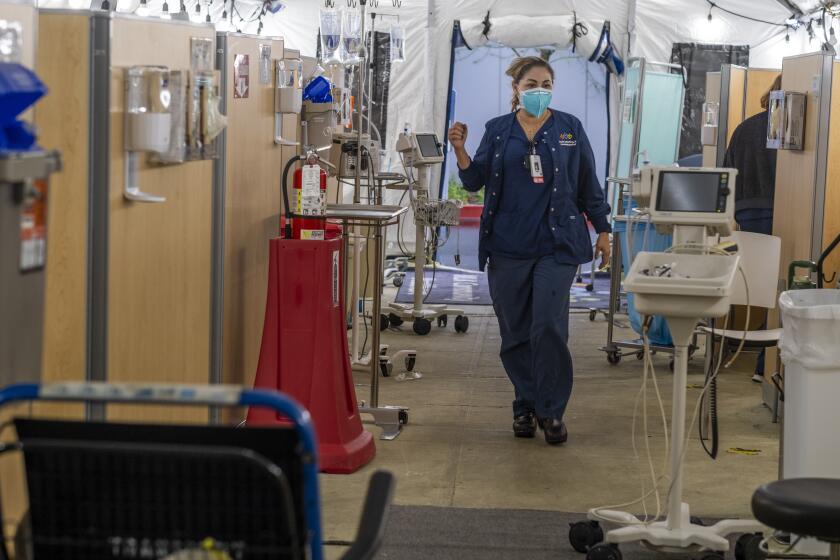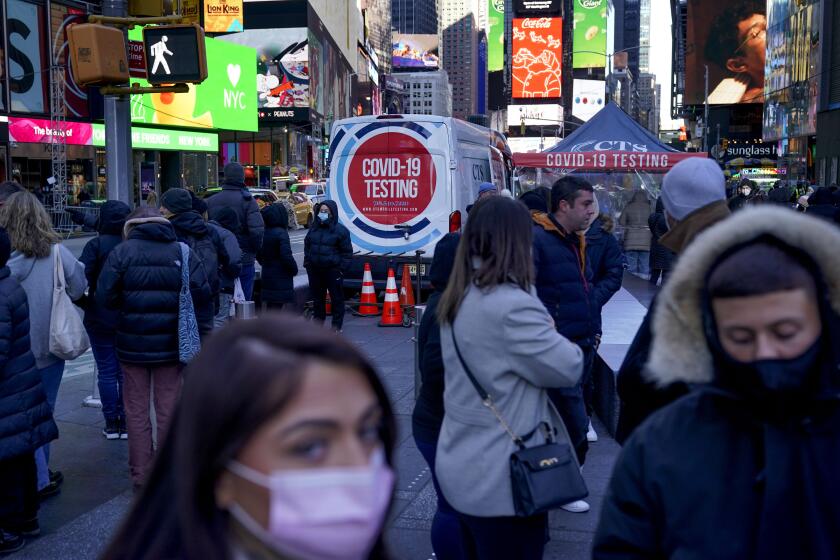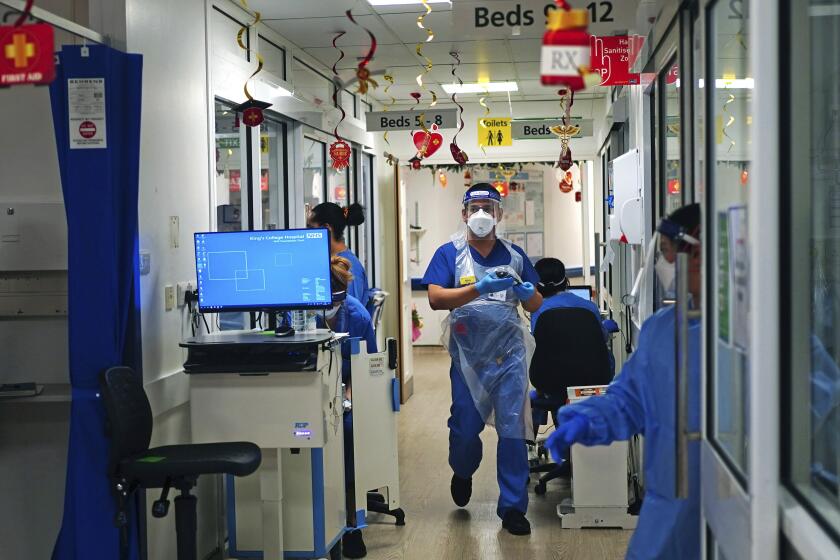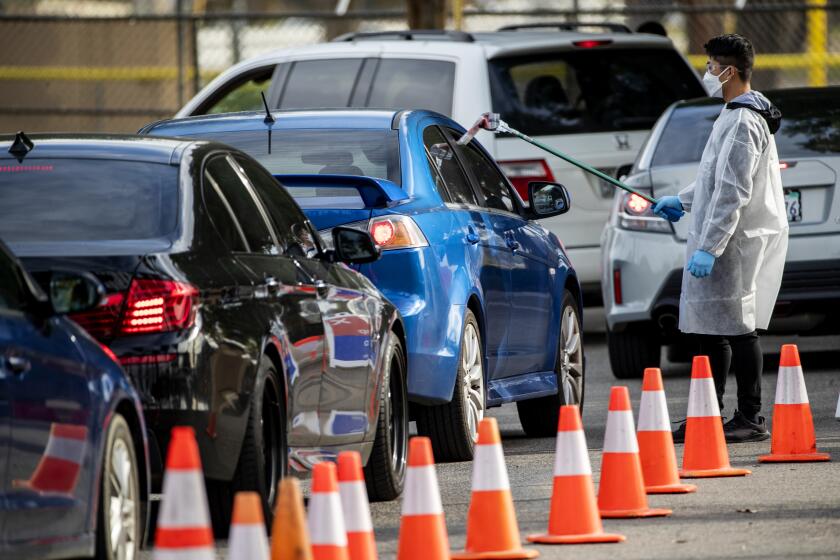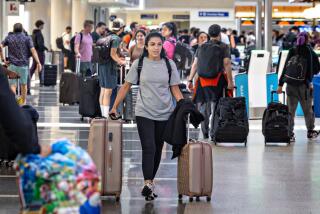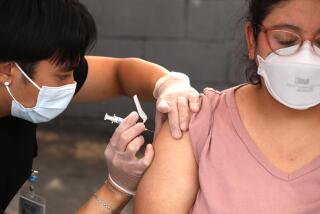With Omicron surging, California calls for stricter COVID isolation for infected people
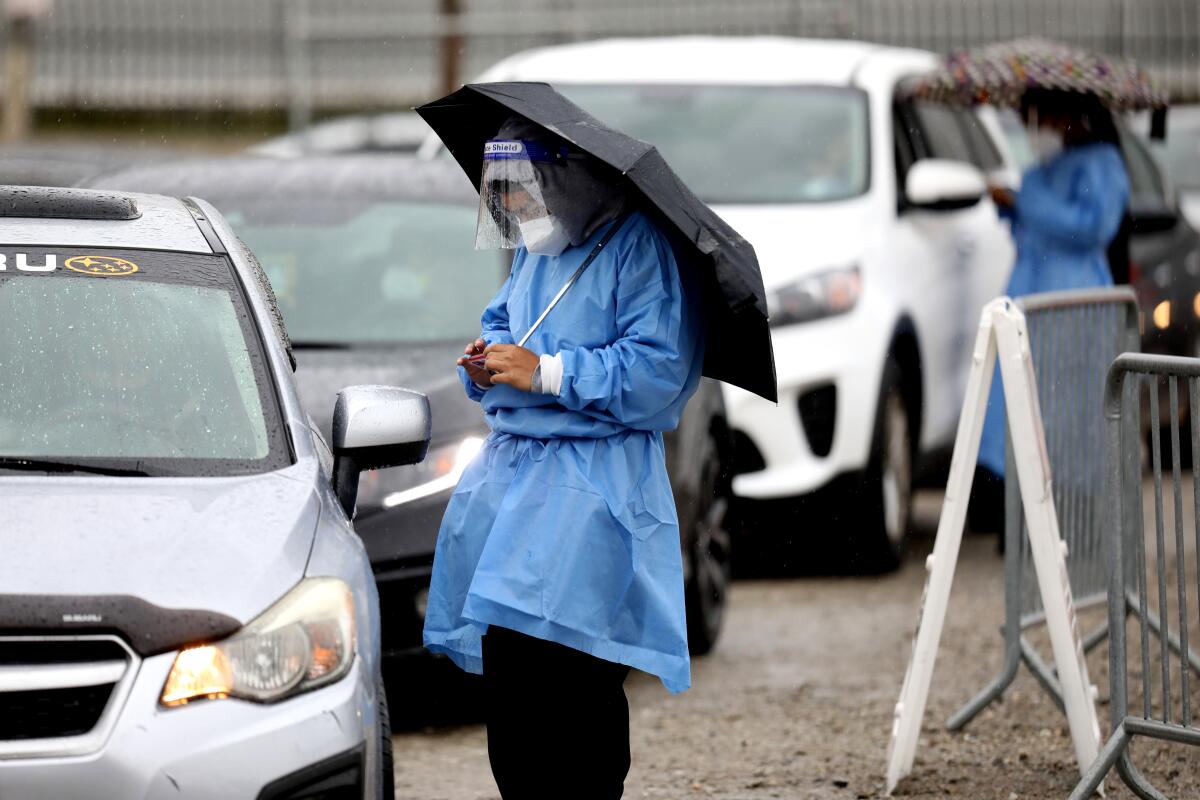
- Share via
With California’s coronavirus surge worsening, the state has issued new recommendations for when people infected with the virus can end their isolation, guidance that is stricter than what was made earlier this week by the U.S. Centers for Disease Control and Prevention.
California is now recommending that asymptomatic, coronavirus-infected people can exit isolation after the fifth day following a positive test, but only if they get a negative test result.
By contrast, the CDC’s recommendations don’t ask for a follow-up negative test; the CDC only recommends that those ending isolation continue wearing a mask around other people for five additional days.
Dr. Robert Wachter, chair of the UC San Francisco Department of Medicine, praised California’s stricter guidelines. “Kudos,” Wachter wrote. “Safer than [CDC’s] version.”
The move comes as the Omicron surge is reaching new highs.
Thursday’s total, 20,198, is one of the highest in the pandemic. Over the last two days, the nation’s most populous county has reported nearly 37,000 new cases.
Los Angeles County on Thursday reported more than 20,000 new cases, fueled in part by the highly transmissible Omicron variant.
Overall, California’s reported average daily coronavirus caseload has more than quadrupled in the last two weeks — an astonishing rise that has pushed infection levels significantly higher than during the summer surge linked to the Delta variant.
“The risk for virus transmission has never been higher in our county,” Los Angeles County Public Health Director Barbara Ferrer said Thursday.
The Los Angeles County Department of Public Health endorsed California’s new isolation recommendations and will codify them in its latest local mandatory health order.
The new California recommendations still largely mirror the CDC’s guidelines. Both shorten the minimum time recommended for isolation from 10 days to five for asymptomatic people.
Both the CDC and California also suggest the quarantine of people who are not up-to-date on their booster shots if they have been exposed to someone who tests positive for the coronavirus.
Officials recommend calling 911 if you have difficulty breathing, chest pain or pressure on the chest; bluish lips or face; are confused or hard to wake; or have other emergency symptoms.
The Omicron variant is believed to be two to four times as contagious as the previously dominant Delta. People who are eligible for booster shots but haven’t yet received them are at increased risk for infection.
“Data from South Africa and the United Kingdom demonstrate that vaccine effectiveness against infection for two doses of an mRNA vaccine is approximately 35%. A COVID-19 vaccine booster dose restores vaccine effectiveness against infection to 75%,” the CDC said in a statement.
The CDC’s decision to shorten the recommended COVID-19 isolation and quarantine period from 10 days to five is drawing criticism.
Here’s a summary of California’s new guidelines to exit isolation:
If you test positive for the coronavirus:
- Stay home for at least five days after the onset of symptoms or after you were tested, regardless of vaccination status, even if you have no symptoms.
- After the fifth day, you can exit isolation if a test shows you are negative, and you have no symptoms or symptoms are resolving. (Officials recommend getting a rapid antigen test for this purpose, as PCR tests — which require saliva or nasal swabs be sent to a lab for processing and take a day or two to get results — are so sensitive that they can show a positive test result for several months, long after you’ve stopped being contagious.)
- These state guidelines will be requirements in L.A. County. “You can’t be a ‘positive’ person and decide on Day 6, you’re leaving isolation in L.A. County. You can leave if you’ve had a negative test on Day 5, you’re asymptomatic or your symptoms have dramatically improved, and you’re fever-free,” Ferrer said.
- If you can’t get a test or choose not to test, you can exit isolation after the 10th day, as long as you have no symptoms or the symptoms are resolving.
- If a fever is present, stay isolated until the fever resolves.
- If symptoms other than fever are not resolving, continue to isolate until symptoms resolve or until after the 10th day.
- Wear a well-fitting mask around other people for 10 days, especially indoors. Surgical masks or higher-grade masks, such as N95, KN95 and KF94, are recommended.
- Cooperate with local contact tracing staffers with your local health department, who will notify people you’ve been around while you were infectious.
Here’s what scientists are watching for as they gauge what Omicron has in store for us this winter.
If you’ve been exposed but haven’t fallen ill or tested positive:
Recommendations on how to act following an exposure to someone who tests positive for the coronavirus differ depending on your vaccination status and whether you’re up-to-date on booster shots.
If you’re recently vaccinated or had a booster shot and you’ve been exposed:
- Get tested on the fifth day after being exposed to a coronavirus-positive person.
- Wear a well-fitting mask such as an N95, KN95 or KF94 around others for 10 days, especially indoors.
- If you test positive, follow isolation recommendations.
- If symptoms develop, test and stay home.
If you’re unvaccinated or haven’t been boosted and have been exposed:
- Stay home for at least five days after your last contact with a person who has tested positive for the coronavirus.
- Test on the fifth day.
- The quarantine can end after the fifth day if symptoms are not present and a test taken on the fifth day or later is negative.
- If you’re unable to test or choose not to and have no symptoms, the quarantine can end on the 10th day.
- Wear a well-fitting mask around others for 10 days, especially inside.
- If you test positive, follow the isolation recommendations.
- If symptoms develop, test and stay home.
Early research points to mutations in the spike protein. But much remains unknown or unconfirmed.
Vaccinated people are eligible for booster shots six months after their second dose of the Pfizer-BioNTech or Moderna shots, and two months after the primary dose of the Johnson & Johnson shot.
A close contact is when someone has spent at least 15 minutes over a 24-hour period within six feet of someone who has tested positive for the coronavirus.
What does it mean to stay at home during isolation?
- Stay home except to get medical care.
- Get food delivered to you or have someone drop off food.
- Don’t have visitors.
- Wear a face covering around others, including family members and housemates.
- Disinfect a shared bathroom after each use, or use a separate bathroom if possible.
- Open windows if you must be in a shared space.
- Stay at least six feet away from other people, especially higher-risk people such as those 65 and older; are severely overweight; have a chronic disease such as cancer, diabetes and heart or lung disease; or have a weak immune system.
More to Read
Sign up for Essential California
The most important California stories and recommendations in your inbox every morning.
You may occasionally receive promotional content from the Los Angeles Times.
